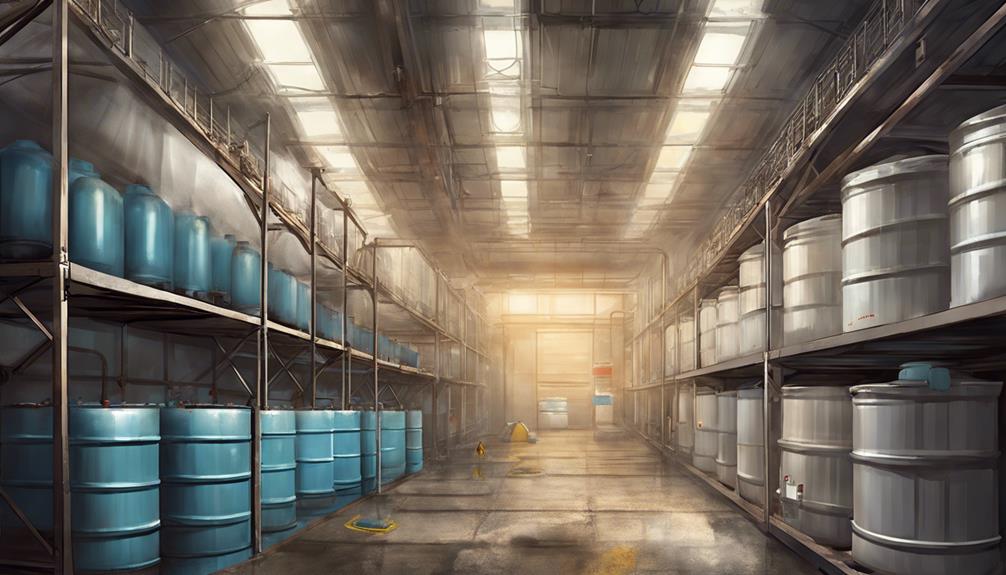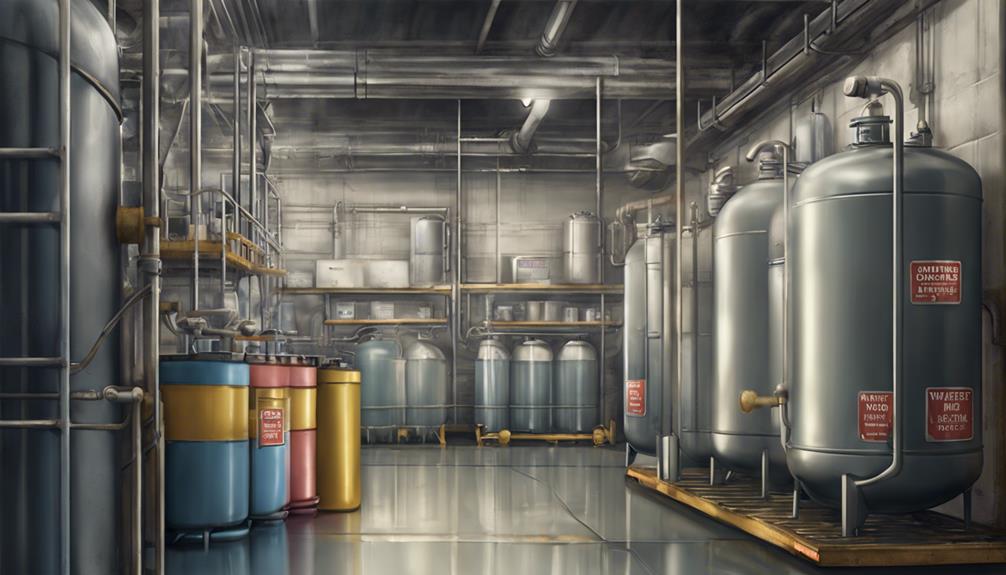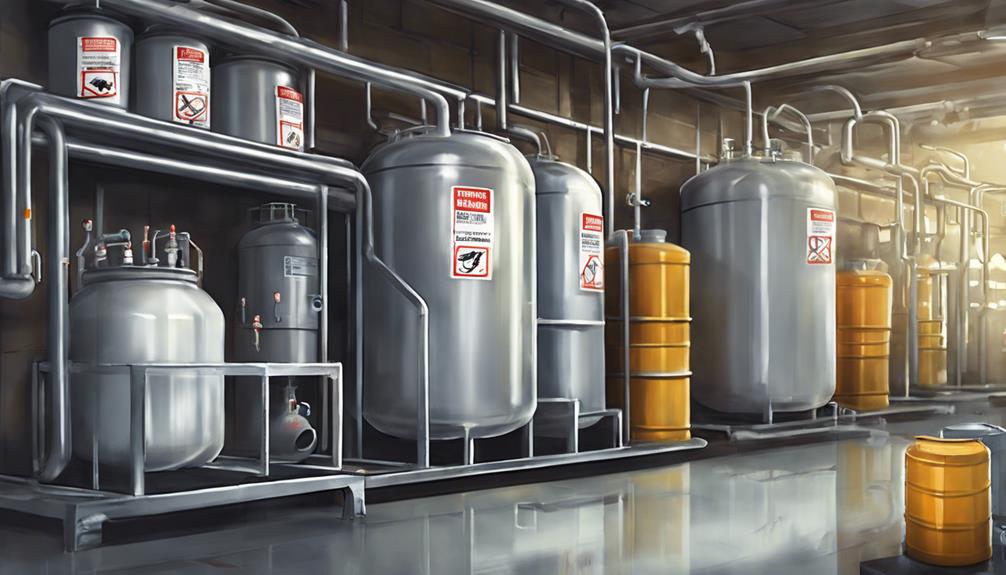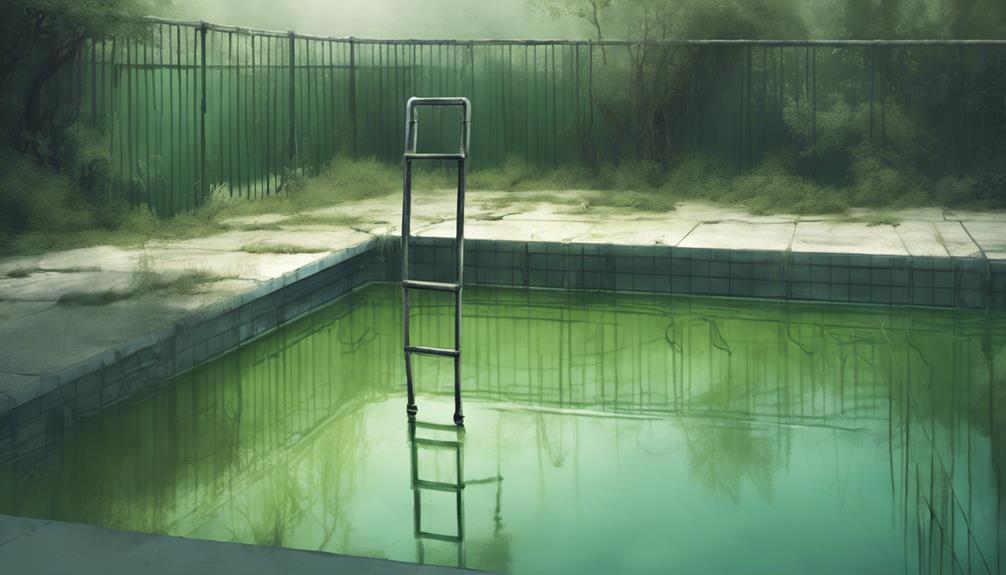Proper storage of chemicals is crucial for safety, preventing hazardous reactions, and creating a secure environment. Sealed containers are important in preventing leaks, ensuring integrity, and reducing accidents. It is recommended to store chemicals in cool, dry, and well-ventilated areas for stability. Stacking containers can increase risks such as seepage and creating dangerous mixtures. Avoid storing chemicals in water-prone areas to prevent corrosion and accidents. Implementing strict guidelines, separating containers, and using original packaging are all important measures for safety. It is essential to understand and follow these guidelines for safe chemical storage and maintaining a secure working environment.
Key Takeaways
- Proper sealing techniques prevent leaks and maintain chemical integrity.
- Storing containers separately reduces hazardous reactions and accidents.
- Cool, dry, well-ventilated storage areas ensure chemical stability and safety.
- Avoid stacking containers to prevent seepage, breakage, and dangerous reactions.
- Keep chemicals away from water-prone areas to avoid corrosion, explosions, and accidents.
Importance of Proper Chemical Storage
Proper chemical storage is vital in maintaining a safe and controlled environment to prevent hazardous incidents and guarantee the longevity and effectiveness of stored chemicals.
By adhering to strict storage guidelines, such as keeping chemicals sealed in their original containers, the risk of hazardous reactions can be greatly reduced.
Mixing certain chemical compounds can lead to fires, explosions, and gas releases, emphasizing the importance of using separate scoopers and avoiding cross-contamination.
Original containers play an essential role in preventing chemical reactions and maintaining the integrity of the stored substances. Even slight traces of other chemicals can have catastrophic consequences, underscoring the necessity of meticulous storage practices to secure a safe working environment.
Sealed Container Guidelines
When storing chemicals, it is important to adhere to strict guidelines regarding the sealing of containers to prevent hazardous incidents. Here are three essential points to keep in mind:
- Use Proper Sealing Techniques:
Make sure lids are tightly closed to prevent leaks and spills.
- Check for Damage:
Inspect containers for cracks or defects that may compromise the seal.
- Label Clearly:
Clearly mark containers with the chemical name, hazard warnings, and storage instructions to prevent mix-ups.
Following these guidelines will help maintain the integrity of the chemicals, reduce the risk of accidents, and create a safe storage environment.
Ideal Storage Conditions

For best chemical storage, maintaining ideal environmental conditions is important to guarantee safety and effectiveness. Storing chemicals in a cool, dry, and well-ventilated place is essential to prevent leaks, degradation, and accidents. Temperature-controlled environments help maintain chemical stability and prevent hazardous reactions. Below is a table showcasing key points for ideal storage conditions:
| Ideal Storage Conditions | Benefits |
|---|---|
| Cool Environment | Prevents chemical degradation |
| Dry Environment | Avoids leakages and chemical reactions |
| Well-Ventilated Area | Prevents gas leaks and accidents |
| Temperature-Controlled Space | Maintains chemical stability |
Risks of Stacking Containers
Stacking containers for chemical storage poses significant risks that can lead to hazardous outcomes. Here are three pivotal risks associated with stacking containers:
- Increased Risk of Chemical Seepage: When containers are stacked, there is a higher chance of leaks or spills, which can result in chemical exposure and environmental contamination.
- Potential for Breakage: Heavy containers stacked on top of each other may break under pressure, causing dangerous chemical mixtures and increasing the risk of accidents.
- Dangerous Chemical Reactions: Mixing chemicals from stacked containers can lead to unforeseen reactions, such as fires, explosions, or the release of toxic gases, posing serious threats to safety.
It is essential to store chemical containers separately to mitigate these risks effectively.
Avoiding Water-Prone Areas

Moisture poses a significant risk in chemical storage areas, leading to corrosion and potentially hazardous reactions when combined with chemicals. It is essential to avoid water-prone storage areas to prevent such dangers. Water mixing with certain chemicals can result in the release of noxious gases or even fires. Ideal storage places include temperature-controlled basements or well-ventilated rooms. Below is a table summarizing the risks of storing chemicals in water-prone areas:
| Risk | Consequence | Prevention |
|---|---|---|
| Corrosion | Damage to containers and chemical reactivity | Store in a water-free environment |
| Release of noxious gases | Inhalation hazards and potential explosions | Ensure proper ventilation in storage areas |
| Chemical degradation | Reduced effectiveness of chemicals | Keep chemicals in dry conditions |
| Increased risk of accidents and injuries | Exposure to dangerous chemical reactions | Avoid storing chemicals in areas prone to water leakage |
Frequently Asked Questions
Can I Store Different Types of Chemicals Together if They Seem Similar?
Storing different types of chemicals together, even if they seem similar, can be hazardous. Mixing chemicals can lead to reactions, fires, explosions, and gas releases. Always keep chemicals separated to prevent dangerous outcomes and guarantee safety.
What Should I Do if I Accidentally Mix Chemicals in the Wrong Container?
Inadvertently mixing chemicals in the wrong container can lead to hazardous reactions. 'Better safe than sorry' – guarantee proper labeling, avoid mixing unknown substances, and seek expert advice if unsure. Immediate ventilation and evacuation might be necessary.
Are There Specific Temperature Ranges for Storing Different Types of Chemicals?
Different types of chemicals have specific temperature requirements for safe storage. It is important to adhere to these guidelines to prevent chemical degradation, leaks, or reactions. Proper temperature control guarantees chemical stability and minimizes risks.
How Can I Prevent Accidental Mixing of Chemicals if I Have Limited Storage Space?
How can you prevent accidental mixing of chemicals in limited space? Opt for smaller quantities, utilize clear labeling, segregate incompatible chemicals, and implement a strict organization system. Prioritize safety to avoid hazardous reactions and guarantee proper storage.
Are There Alternative Storage Options for Chemicals if I Live in a Humid Environment?
When living in a humid environment, consider storing chemicals in temperature-controlled basements or well-ventilated rooms. Avoid water-prone areas to prevent corrosion and gas release. Proper storage prevents accidents and chemical degradation, ensuring safety and efficacy.
How can Proper Chemical Storage Improve Pool Energy Efficiency?
Proper chemical storage can revolutionize your pool’s energy efficiency by reducing the amount of energy needed to maintain water quality. By storing chemicals in a cool, dark place, they can maintain their potency and effectiveness. This means less energy is required to keep the pool clean and properly balanced.
How Can Chemical Storage Safety Guidelines also Help Protect Children in a Pool Setting?
When it comes to pool safety, following essential pool safety tips is crucial to protect children. Similarly, applying chemical storage safety guidelines can also help prevent accidents in a pool setting. By safely storing pool chemicals, you can minimize the risk of exposure to harmful substances and protect children from potential harm.
How can chemical storage safety guidelines also be applied to ensure child safety in a pool environment?
When it comes to pool safety, essential pool safety tips can also be applied by chemical storage safety guidelines. By keeping pool chemicals securely stored and out of reach of children, you can prevent accidents and ensure the safety of kids in a pool environment.
How Can Chemical Storage Safety Guidelines Help Ensure Pool Safety When Adding Waterfalls?
Adding stunning pool waterfalls upgrade can enhance the aesthetic appeal of a pool. However, it’s crucial to follow chemical storage safety guidelines to ensure pool safety. Proper handling and storage of chemicals will prevent accidents and chemical leaks, creating a safe environment for enjoying the new water feature.
How Can I Ensure Chemical Safety When Installing a Waterfall in My Pool?
When installing stunning pool waterfalls revamp, it’s crucial to ensure chemical safety. Use non-toxic chemicals and follow safety instructions on the labels. Regularly test the water for chemical balance and maintain proper filtration. Keep all chemicals securely stored away from the waterfall to prevent contamination.
Conclusion
To sum up, neglecting proper chemical storage practices is akin to playing with fire in a dry forest, inviting disaster and chaos.
By adhering to the guidelines outlined in this article, individuals can create a protective shield against potential hazards and guarantee the safe handling of chemicals.
Remember, the consequences of lax storage procedures can be catastrophic, making it crucial to prioritize safety at all times.










